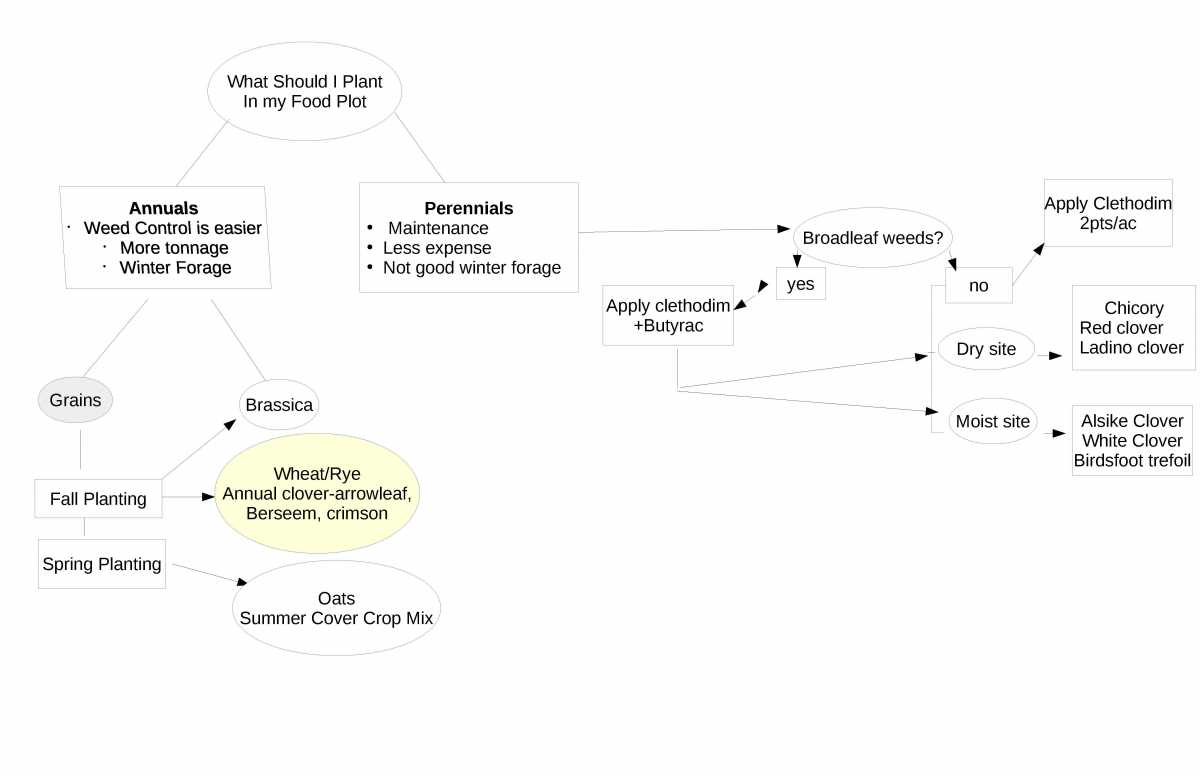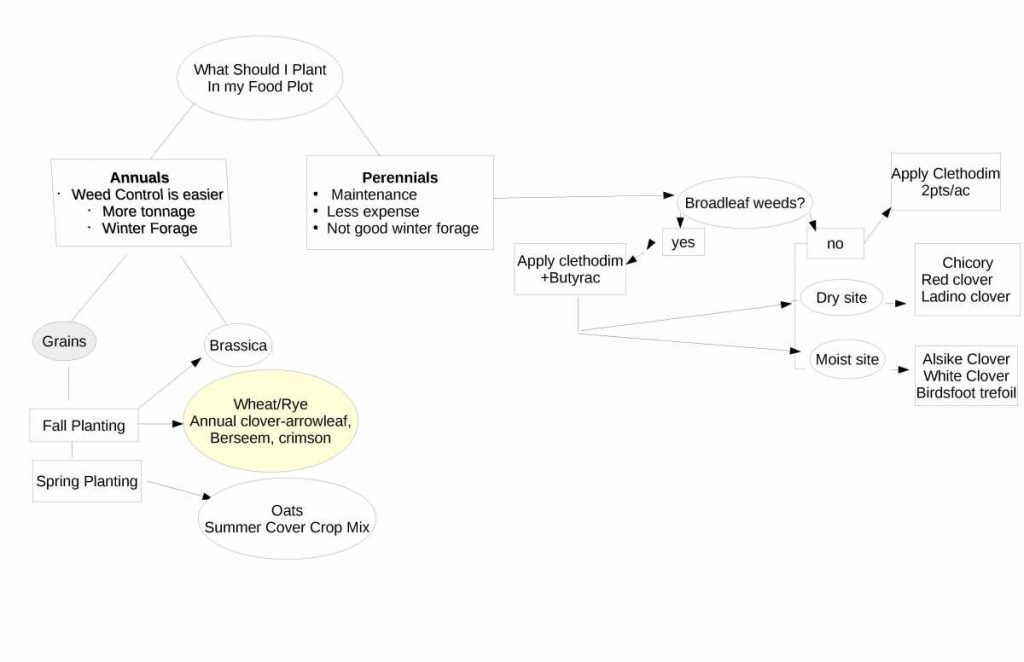What to Plant in a Deer Food Plot?
There is so much information out there about what the best food plot seeds to buy. Most of the information is pure advertising designed to offer a little bit of advise but mostly to sell a bag of over-priced seed. It can be overwhelming sometimes and causes people to stress out about the decision. I once watched a guy stand in the Tractor Supply agonizing over what shiny bag seeds to buy for his plots. I felt sorry for the guy so went over to offer some advice as to what was available.
Thinking about what to plant on some client plots this year where I have had lots of problems, I thought it might be helpful to come up with a decision chart that one can take a look at the make a good decision. Remember, you only get one season to get it right, so plant the right thing for your situation. Here is the chart:
The Deer Food Plot Seed Decision Chart

Its not the prettiest decision tree around but I think it gives a guy a pretty good basic flow chart to decide quickly what way to go when you are trying to decide what to plant in your deer food plots.
So, when you are trying to decide what to plant in deer food plots, simply open up this article and take a look at the decision tree.
Annuals or Perennials?
This first big decision to make is whether you want annual food plots or perennial food plots, or both.
Popular annuals include oats, wheat, rye, triticale, in other words grains and brassicas. The advantage of annuals is that you can mix them together, you can separate them within the same food plot. You can get a tremendous amount of tonnage of forage for deer. One of the most important aspects of annuals is that you can plant them in late summer and provide feed into and through winter. In the case of cereal grains, they will be the first thing to green up in the spring. Nothing really beats brassicas as a draw and provide good forage late in the fall.
Another advantage is that it is easy to terminate it when you are ready to replant. A good shot of 2qts/acre of glyphosate will kill the planting if you want to put something else in the plot or if you are ready to replant for fall hunting.
You can plant spring oats in spring or broadcast them into over-wintering grains if they are thin. You can also decide to plant clover as a frost seeding in late winter and as the grains die out, they will come into the plot and take it over.
Most food plotters who use cereal grains and brassicas, plant them in late summer. Brassicas should be planted by Labor Day. Wheat and rye can be planted up to mid-September. The best way is to sprinkle brassicas on top and roll and spray whatever is in the field. For cereal grains, its best to drill it in. Both ahead of rains.
Cover Crop Cocktail Annuals
When you are planting fall food plots, its a great idea to plant a mix. This improves soil health as well as provides a great buffet for deer. Some good choices are: annual clovers like berseem, crimson and arrowleaf. I like to put some winter peas in my cover crop mix along with radishes. All of these plants will come up in spring and provide great protein to deer coming out of winter hungry.
Summer Cover Crop Cocktails
If you plant in the spring, you will want to plant oats, american joint vetch, cow peas, pasja (brassica), barley. If you are starting from scratch in spring, you can start with this mix then drill in the fall blend in September for a year-round food plot.
One of the great things about these annual cover crops is weed control. The thick and early growth of the plants will suppress weeds and if you have some weeds coming up in areas where deer eat everything down to the dirt, you can spray it and replant it easily.
Perennial Food Plots
Perennial plots usually are made up of clover and other forbs like chicory, burnett and native forbs that are palatable to deer. The advantage to perennials is that you don’t necessarily have to replant them each year.
Having said that, don’t get the idea that once you have it planted, you never have to touch it again. I have many clients who neglect simple and easy maintenance practices. Clover plots can get wiped out by deer and they don’t really provide anything for deer up in the northern climate. But, you can’t beat it in spring and summer.
Perennial Food Plot Maintenance
Put away the mower and buy a good sprayer. You can spray by hand or use an ATV sprayer to spray when you get taken over by grass or broadleaf weeds. I have problems with thistle, daisy, milkweed, stiltgrass and mullen on my plots because the deer keep the clover trimmed down so low that weeds can establish. In this case, some mowing may be appropriate to keep them from going to seed. When you have something like thistles, its imperative that you spray and cut the flowers off or you will never get ahead of it there are so many seeds.
Keeping Grasses off Your Food Plots
I also have big problems with stiltgrass and foxtail. Stiltgrass is an invasive from Japan that is very aggressive and a prolific seeder as is foxtail. Once these grasses go to seed, you are screwed for years, so make sure you spray for grasses properly with clethodim. It takes little effort and expense to spray. So don’t skip it.
Every March, it is a good idea to overseed a light seeding of new clover.
I like to mix white and red clover in the same mix. Red is taller and stemmier and will put up with more drought and last longer and white clover has a lot of good tasty leaves. If you don’t have a broadleaf weed problem, add chicory to your clover plots. I have seen bucks in early season pick the chicory leaves out of a clover plot and not touch any clover.
If you have some broadleaf weeds you will need to spray with 2,4db or butaryc 200 according to the label. You can tank mix with clethodim to keep your clover plots clean.
So, try following the decision tree provided to pick what you want to plant, I hope it comes in handy.
If you want to have me come out to consult on your property, please call me to discuss it at 814-360-4510 and we can set up a site visit.

